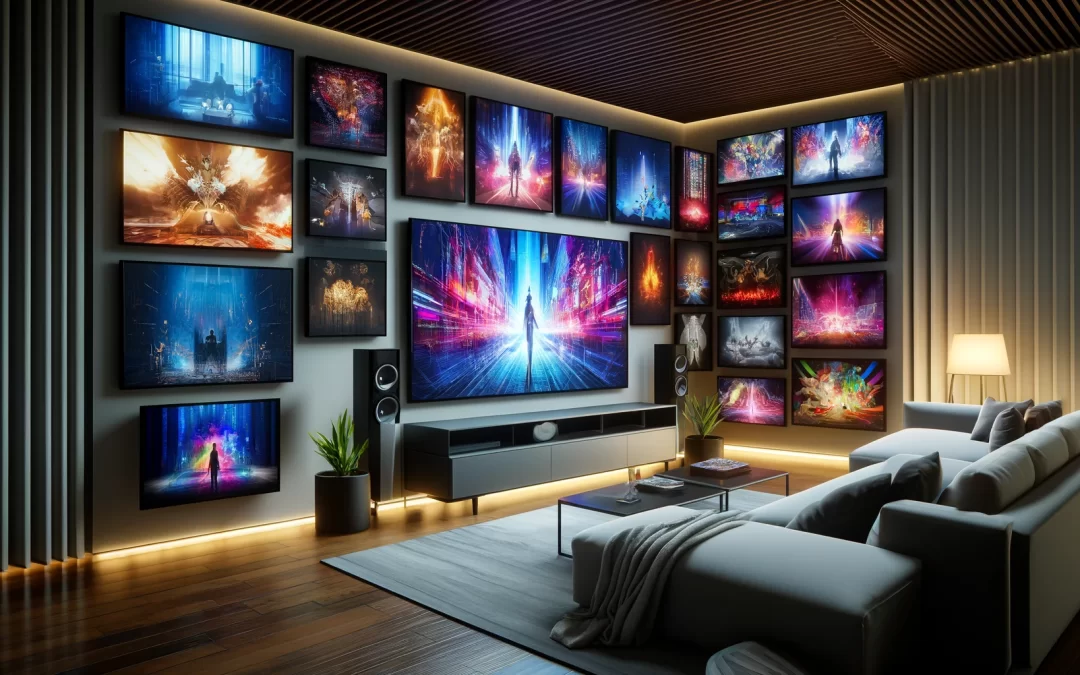When it comes to upgrading your home entertainment setup, selecting the right flat screen TV is crucial. Modern televisions not only enhance your viewing experience with crystal-clear images and vibrant colors, but they also come packed with a variety of smart features. Whether you’re watching your favorite movies, binging on TV series, or gaming, the perfect flat screen TV can transform your leisure time into an immersive adventure. This article explores the top 10 flat screen TVs available, showcasing their key features, pros, cons, and detailed descriptions to help you make an informed choice.
1. Samsung QN90A Neo QLED TV (Amazon)
- Key Features: Neo QLED technology, Quantum HDR 32X, 120Hz refresh rate, built-in Alexa, 4K AI upscaling
- Pros: Exceptional brightness and contrast, precise backlighting control, minimal glare, extensive smart features, great for gaming
- Cons: Premium price, limited viewing angles, occasional software bugs
- Description: The Samsung QN90A represents the pinnacle of QLED technology, offering viewers stunning visual clarity and brightness. This TV excels in both dark and brightly lit environments thanks to its Quantum HDR 32X, which intensifies hues for a lifelike viewing experience. The 120Hz refresh rate and 4K AI upscaling make it a favorite among gamers and cinephiles alike. While the price is on the higher side, the investment translates to a cutting-edge viewing experience. It’s perfect for those who value picture quality and feature-rich smart capabilities in their home entertainment system.
2. LG CX OLED (Amazon)
- Key Features: Self-lit OLED pixels, α9 Gen 3 AI Processor 4K, Dolby Vision IQ and Atmos, NVIDIA G-SYNC compatible, webOS smart platform
- Pros: Deep blacks and infinite contrast, exceptional color accuracy, fluid webOS interface, excellent gaming performance
- Cons: Risk of burn-in with static images, higher power consumption, premium pricing
- Description: The LG CX OLED is a standout for its remarkable picture quality driven by self-lit pixels which deliver perfect blacks and intense colors. Enhanced by the α9 Gen 3 AI Processor, it offers both AI picture pro and AI sound pro, adapting to content and room conditions. Gamers will appreciate the NVIDIA G-SYNC compatibility, ensuring smooth gameplay. Though OLEDs are prone to burn-in, the CX’s features mitigate this risk effectively. Ideal for those who demand unparalleled picture quality and smart functionality in their gaming and viewing experience.
3. Sony X90J (Amazon)
- Key Features: Full Array LED, Cognitive Processor XR, Google TV, HDMI 2.1, XR Motion Clarity
- Pros: Brilliant color reproduction, excellent contrast, robust sound quality, good for gaming, intuitive Google TV interface
- Cons: Slightly slower operating system, some blooming in HDR mode, limited brightness compared to OLED
- Description: Sony’s X90J is powered by the Cognitive Processor XR, designed to deliver a picture that feels deep, natural, and real. The full-array backlighting provides superior brightness and more precise contrast than typical LEDs. With Google TV, users gain access to a vast array of streaming apps and services. The X90J’s HDMI 2.1 support makes it a solid choice for next-gen gaming consoles. This TV is best suited for someone looking for an all-around performer with exceptional cinematic and gaming capabilities.
4. TCL 65-Inch Q7 QLED 4K Smart Google TV (65Q750G) (Amazon)
- Key Features: 4K QLED display, HDR Pro Pack with Dolby Vision, 144Hz CMI (Clear Motion Index), Hands-Free Voice Control, Google TV integration
- Pros: Vivid picture quality with deep blacks and rich colors, enhanced motion clarity for sports and gaming, extensive HDR support, intuitive voice control, seamless Google TV smart platform
- Cons: Limited peak brightness compared to higher-end models, occasional software glitches, some blooming in high-contrast scenes
- Description: The TCL 65Q750G is designed to bring cinematic quality into the home with its 4K QLED technology that enhances the vibrancy and clarity of images. The HDR Pro Pack, including Dolby Vision, ensures that movies and games are seen with the utmost detail and color accuracy. Gamers and sports enthusiasts will appreciate the 144Hz CMI, which provides smoother action scenes and less motion blur. Voice control capabilities allow for easy operation without the need for a remote, and Google TV offers a wide range of streaming apps and personalized recommendations. However, while the TCL 65Q750G performs admirably in many areas, it may not satisfy those looking for the ultimate brightness levels found in more expensive models. Despite this, it stands out as a solid choice for those seeking advanced features without breaking the bank.
5. Hisense U8H (Amazon)
- Key Features: ULED technology, Quantum Dot color, 120Hz native refresh rate, Android TV, Full Array Local Dimming
- Pros: High peak brightness, impressive HDR performance, good gaming features, affordable price for the technology
- Cons: Inconsistent OS performance, some haloing effects, limited sound quality
- Description: The Hisense U8H is an excellent entry into the world of high-performance TVs at a lower cost. Featuring ULED and quantum dot technologies, it offers vibrant colors and deep blacks. The 120Hz refresh rate and full array local dimming enhance both fast-moving scenes and shadow details, making it ideal for both cinematic content and gaming. Though the Android TV interface may show occasional sluggishness, the U8H remains an attractive option for those who prioritize picture quality and smart features on a budget.
6. VIZIO 75-Inch P-Series 4K QLED HDR Smart TV(Amazon)
- Key Features: 4K QLED panel, Full Array with 240 Local Dimming Zones, Dolby Vision HDR, VIZIO SmartCast, up to 1200 nits peak brightness, ProGaming Engine
- Pros: Outstanding brightness and clarity, powerful HDR performance, robust local dimming feature, excellent for gaming and cinematic content, intuitive SmartCast platform
- Cons: SmartCast lacks some app support, slight input lag in some gaming scenarios, complex menu navigation
- Description: The VIZIO 75-Inch P-Series enhances your viewing experience with its top-notch 4K QLED display that delivers exceptional detail and color accuracy. Its Full Array backlighting with 240 local dimming zones ensures deep blacks and striking contrast, ideal for HDR content. With Dolby Vision HDR, you get cinematic viewing at home, making this TV a preferred choice for movie enthusiasts. The included ProGaming Engine makes it equally appealing to gamers, offering features like variable refresh rate and low input lag for a smooth gaming experience. VIZIO’s SmartCast platform, while comprehensive, could benefit from a wider selection of native app support but generally provides a user-friendly experience with plenty of streaming options. While navigating the settings might require some learning, the overall performance of this TV makes it a strong contender in the premium TV market.
7. Samsung The Frame (Amazon)
- Key Features: Art Mode, customizable frames, QLED technology, 100% color volume, smart TV capabilities
- Pros: Unique design that blends with home decor, excellent color accuracy, effective smart features, customizable appearance
- Cons: Higher price for aesthetic features, average sound quality, reflective screen
- Description: Samsung’s The Frame 2021 is not just a TV but a piece of art. Perfect for those who value aesthetics as much as functionality, it features Art Mode, which allows the TV to display beautiful artworks when not in use. The customizable frames can match any decor, making it a seamless addition to any living space. While you pay a premium for its design, the QLED technology ensures that the picture quality does not suffer, making it ideal for those who want their TV to be both a media hub and a decorative element.
8. LG G1 OLED (Amazon)
- Key Features: OLED evo technology, Gallery Design, α9 Gen 4 AI Processor 4K, Dolby Vision IQ and Atmos, webOS 6.0
- Pros: Improved brightness over traditional OLEDs, stunning picture quality, sleek, flush wall-mount design, advanced AI capabilities
- Cons: Premium price, risk of burn-in, requires careful handling during installation
- Description: The LG G1 OLED brings innovation with its OLED evo technology, which provides better luminosity for higher brightness and sharper images. This TV is designed to blend into your space like a piece of art, with a gallery design that sits flush against the wall. Enhanced with the α9 Gen 4 AI Processor, it optimizes both the picture and sound quality. While it commands a higher price and careful installation, the G1 is perfect for design-conscious buyers looking for top-tier technology.
9. Sony A8H OLED (Amazon)
10. TCL 75-inch 6-Series 4K UHD Dolby Vision HDR QLED Roku Smart TV (Amazon)
- Key Features: Mini-LED QLED, 4K HDR Pro Pack with Dolby Vision, THX Certified Game Mode, Roku TV smart platform, Contrast Control Zone technology
- Pros: Excellent value for money, superior contrast and brightness, robust HDR support, user-friendly Roku interface
- Cons: Limited viewing angles, some motion blur in fast action scenes, build quality not on par with higher-end models
- Description: TCL continues to offer competitive pricing without compromising on quality. The 75-inch 6-Series is a testament to that, featuring Mini-LED technology for enhanced brightness and contrast. Dolby Vision HDR brings spectacular color and detail to your favorite content. With Roku built-in, it offers a seamless streaming experience, making it a great choice for those looking for a balance between performance and price.
Choosing the right flat screen TV involves considering a blend of performance, features, and budget. From the premium Samsung QN90A and LG CX OLED for the ultimate home theater experience to the more budget-conscious options like the TCL 5-Series, there’s a TV to fit every need and space. When selecting your next TV, consider the lighting in your room, the primary use of the TV, and how the features of each model enhance your viewing experience. Whether for gaming, cinematic viewing, or casual watching, these top 10 flat screen TVs promise to elevate your home entertainment to new heights.
FAQ’s
What are the key differences between 4K, QLED, and Ultra HD televisions?
4K and Ultra HD (UHD) are often used interchangeably to describe the resolution of a television, which is 3840 x 2160 pixels, offering four times the resolution of standard 1080p HD. The term “4K” is more commonly used in the cinema industry, whereas “Ultra HD” is more prevalent in consumer electronics. On the other hand, QLED (Quantum Dot LED) refers not to the resolution, but to the technology used to enhance the display’s brightness and color. QLED TVs use a quantum dot film in the display, which improves the color and brightness when compared to standard LED TVs.
How does QLED technology enhance the viewing experience compared to traditional LED TVs?
QLED TVs use a layer of quantum dots that emit light when exposed to an LED backlight. This technology allows for a wider color gamut and brighter colors. Quantum dots can produce more saturated and vibrant colors, which leads to images that are more realistic and can be seen more clearly in various lighting conditions. Additionally, QLED TVs typically offer better brightness levels than traditional LEDs, making them ideal for brightly lit rooms.
What are the benefits of upgrading to a 4K or Ultra HD television?
Upgrading to a 4K or Ultra HD television brings several benefits, the most notable being significantly improved picture quality. The increased resolution offers greater detail, making it ideal for large screens where the difference in detail can be easily noticed. This is especially beneficial for viewing high-resolution content such as movies and TV shows produced in 4K, as well as for gaming where finer details can enhance the experience. Additionally, many 4K TVs also come with better processing capabilities, which can improve the upscaling of lower-resolution content.
Are there any considerations to keep in mind when choosing between 4K, QLED, and Ultra HD TVs?
When choosing between these types of TVs, it’s important to consider the types of content you primarily watch and the lighting conditions in your viewing area. If you consume a lot of HDR content and have a well-lit room, a QLED TV might be more beneficial due to its brightness and color volume. If you’re more focused on the highest possible resolution for gaming or watching movies, a 4K UHD TV is advisable. It’s also important to look at the smart features and connectivity options of the TV to ensure it meets your needs.
What future technologies are expected to compete with or surpass QLED and 4K/UHD TVs?
The next significant technologies in the television market include OLED and MicroLED displays. OLED offers better contrast ratios and true blacks because each pixel is self-lit, which allows for more precise control of brightness and color on a per-pixel basis. MicroLED technology, which is still in the early stages of consumer market penetration, promises even greater brightness and color accuracy than OLED, with potentially longer lifespan and no risk of burn-in. These technologies are expected to continue evolving and may offer superior alternatives to QLED and 4K UHD TVs in the future.





